From the Vault: Headlines drive interest in World War II…
October 24, 2025 by TimHughes · Leave a Comment
For likely a multitude of reasons, interest in World War II newspapers ranks far higher than in the Korean War, World War I, or the Spanish-American War. It may be a generational thing, as most collectors today are children of World War II veterans and likely heard stories of the war first-hand, or found  newspapers in their parents attics which sparked an interest. One could debate a number of other possible reasons why other wars lack the intrigue found in that fought by the “greatest generation”.
newspapers in their parents attics which sparked an interest. One could debate a number of other possible reasons why other wars lack the intrigue found in that fought by the “greatest generation”.
Headline collecting has always been a focus for this hobby, and as any collector knows, bold, banner headlines did not become commonplace until late in the 19th century. With the increasing competitiveness of daily newspapers across the country–Hearst, Pulitzer & others rising to prominence–flashier front pages were needed to draw attention at the corner news stand. It’s a shame there is not more interest in the Spanish-American War and World War I as both events resulted in some huge, dramatic, & very displayable headlines.
Because there are a plethora of newspapers from the WWII era available, collectors have become very discriminating in what they collect. Only the “best of the best” will do, meaning just the major events and only those with huge and displayable headlines. If there is a “top 6” list of sought-after events, our experience is they would be: 1) attack on Pearl Harbor; 2) the D-Day invasion; 3) death of Hitler; 4) end of the war in Europe; 5) dropping of the atomic bomb; 6) end of the war in the Pacific. One could add any number of other battle reports such as Midway, battle of the Bulge, fall of Italy, Iwo Jima, battle for Berlin, and so much more. And we could step back before American involvement in the war and add Hitler’s invasion of Poland and the battle of Britain.
The bigger the headline the better. With some newspapers the entire front page was taken up with a headline and a related graphic. The U.S. flag was a common patriotic device. Tabloid-size newspapers commonly had the front page entirely taken up with a singular headline and tend to be better for display given their smaller size.
 And not just American newspapers draw interest. German newspapers hold a special intrigue, but the language barrier is a problem for many. But the British Channel Islands, located in the English Channel between England & France, were occupied by the Nazi during the war so their reports were very pro-Nazi while printed in the English language (ex., Guernsey Island). And the military newspaper “Stars and Stripes“, while certainly being American, was published at various locations in Europe and the Pacific. Collectors have a special interest in finding World War II events in the official newspapers of the American military forces. Plus there were a multitude of “camp” newspapers, amateur-looking newspapers printed on a mimeograph machine for consumption limited to a military base, and typically printed is very small quantities. Their rarity is not truly appreciated by many.
And not just American newspapers draw interest. German newspapers hold a special intrigue, but the language barrier is a problem for many. But the British Channel Islands, located in the English Channel between England & France, were occupied by the Nazi during the war so their reports were very pro-Nazi while printed in the English language (ex., Guernsey Island). And the military newspaper “Stars and Stripes“, while certainly being American, was published at various locations in Europe and the Pacific. Collectors have a special interest in finding World War II events in the official newspapers of the American military forces. Plus there were a multitude of “camp” newspapers, amateur-looking newspapers printed on a mimeograph machine for consumption limited to a military base, and typically printed is very small quantities. Their rarity is not truly appreciated by many.
For obvious reasons, there is also a high degree of collectible interest from those wishing to make sure certain aspects of history are not forgotten. The Holocaust, and the Nazi propaganda used to provide a rationale for eliminating the Jewish people, is well documented in newspapers from the era. In addition to the Holocaust and its atrocities, issues providing context through reporting other pre-war events such as the Great Depression, fascism, and increased militarism, are also desirable.
True to any collectable field, newspaper collectors are always on the lookout for an issue better than what they have, and collection upgrades are constant. Finding that special, rare, unusual or fascinating headline is what makes the hobby fun. Will interest in the Korean War and the Vietnam War gain more interest in future years? Perhaps so. With interest currently low and availability and prices very attractive, it might be a good time to explore.
The reason I collected it: a single-focus newspaper…
October 13, 2025 by TimHughes · 1 Comment
The general rule for a newspaper of any era is to report the news of the day on a regular basis, typically daily or weekly. Some have a thematic focus whether it be the slavery issue, the military, masonic events, etc., but even such newspapers maintained a history of publishing on a regular basis.
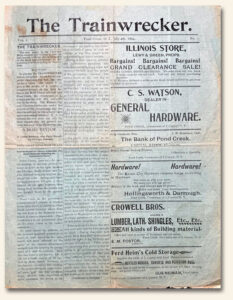 I don’t believe we have previously discovered a newspaper that had a singular focus on a specific event until we acquired “The Trainwrecker” from Pond Creek, Oklahoma Territory, 1894. This is not just a rare title; this could be a unique issue being the volume 1, number 1 issue of a newspaper about which nothing can be found. It is not listed in Gregory’s “Union List of Newspapers”, nor have we found anything on the internet.
I don’t believe we have previously discovered a newspaper that had a singular focus on a specific event until we acquired “The Trainwrecker” from Pond Creek, Oklahoma Territory, 1894. This is not just a rare title; this could be a unique issue being the volume 1, number 1 issue of a newspaper about which nothing can be found. It is not listed in Gregory’s “Union List of Newspapers”, nor have we found anything on the internet.
Its purpose is noted on the front page, and it seems to have a singular focus: the dispute the Pond Creek area had with the Rock Island Railroad.
As a bit of background, I might encourage a visit to “Hell on Rails: Oklahoma Towns at War with the Rock Island Railroad“, which details the backdrop for why this newspaper was created. It is rather convoluted and relates much to how the Indian Territory, now Oklahoma, was settled and how the railroads were a factor in town settlements.
The issue begins with: “The only paper in the Cherokee Strip capable and willing to take up and handle without gloves the action of the Rock Island Railroad, in the pursuance of their policy to rule or ruin.”
Then the “Salutary” begins: “In placing the TRAINWRECKER before the public, we ask for no sympathy–realizing full well the step we have taken. Our object is to give to the people of L county a complete account of the fight between the Rock Island railroad and Pond Creek, the county seat of L county and the only live, energetic city in the Strip…” with much more not just on the front page but on inside pages as well.
It is possible this newspaper existed for just this one issue, but without documenting records we cannot confirm. Printed as it is on green paper, it certainly doesn’t seem as though the publisher planned for a lengthy run.
This is part of the fascination with rare titles, as their scarcity simply implies a lack of information. Although we have encountered other newspapers that failed to exist beyond just a few issues, this is the first that seems to have existed to exploit a singular concern.
Personal note from Guy: “If historical fiction is within your wheelhouse of interests, I found ‘The Assassin’ and ‘The Wrecker’, both by Clive Cussler, fun reads. The former focuses more on the O.T. region (with a mention of some of the locations indicated above), while the latter zeros in on the sabotaging of trains during this era.”
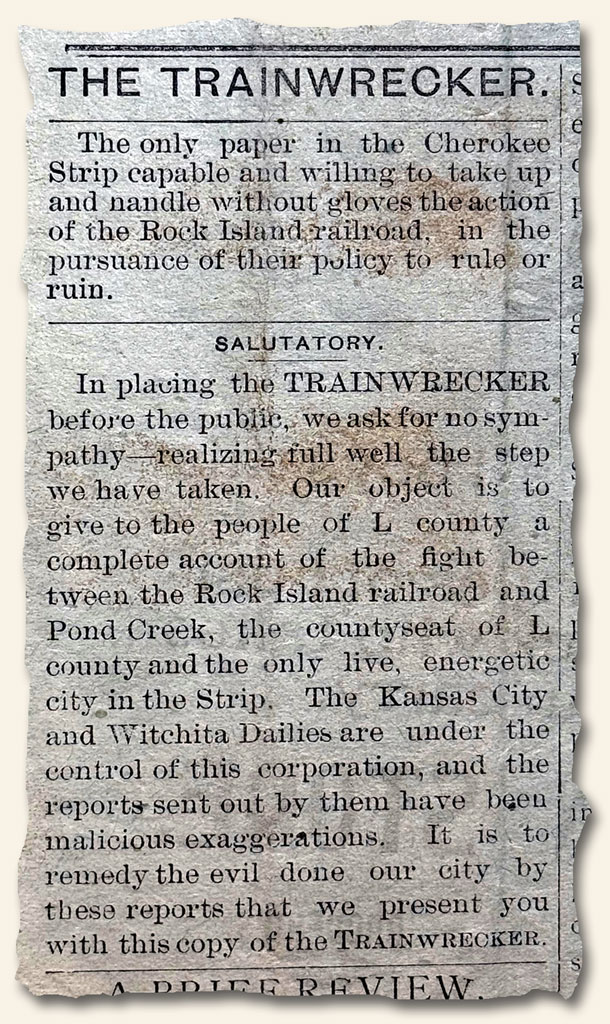
Who’s Who in Newspapers? Citizen Genêt edition…
October 10, 2025 by GuyHeilenman · 1 Comment
The 10th installment of Who’s Who in Newspapers
Citizen who? While exploring newspapers from the 18th and early 19th centuries over the past few decades, I noticed the name “Citizen Genet” appearing more than once—always tied to some sort of “affair.” As a novice historian at the time (my academic background is actually in mathematics and engineering), and given my aversion to sensationalized “yellow journalism,” I let it pass. With tens of thousands of fascinating topics to explore through our beloved collectible, I never stopped to uncover who he really was or what his “affair” involved.
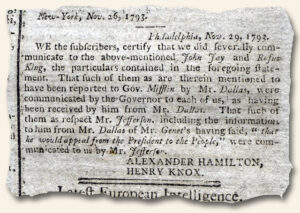 Recently, however, I embraced the old adage that “it’s never too late to learn” and finally took the plunge. What I found was a story worth the effort, one that offered both historical insight and a better appreciation for the newspapers that recorded it. A summary of my discovery is as follows:
Recently, however, I embraced the old adage that “it’s never too late to learn” and finally took the plunge. What I found was a story worth the effort, one that offered both historical insight and a better appreciation for the newspapers that recorded it. A summary of my discovery is as follows:
Edmond-Charles “Citizen” Genet was a French diplomat sent to the United States in 1793 to gain American support for France’s wars with Britain and other European powers. Instead of observing diplomatic protocol, he jumped right into recruiting privateers to attack British ships and encouraging Americans to take up arms against Spain. These moves directly violated President George Washington’s Neutrality Proclamation of 1793. To make matters worse, Genet bypassed Washington altogether and appealed directly to the American public, an act that came across as both disrespectful and threatening to U.S. sovereignty.
The uproar that followed—known as the “Citizen Genet Affair”—quickly became a defining moment in America’s early history. Washington demanded Genet’s recall, reinforcing both the president’s authority in foreign affairs and the new nation’s commitment to neutrality. At home, the controversy deepened political divisions: Federalists supported Washington’s cautious stance, while Democratic-Republicans sympathized with revolutionary France. In the end, Genet was granted asylum in the United States and lived out his life in New York, but his story left behind a lasting lesson in diplomacy and America’s determination to remain independent from foreign influence.
So much for jumping to conclusions regarding his “affair”. I should have known better.
The photos shown are from two articles within the Columbian Centinel, Dec. 11, 1793. – the above in full, and the below of only an excerpt due to the length of the article. If original newspapers on this topic remain available, they would be found at: CITIZEN GENET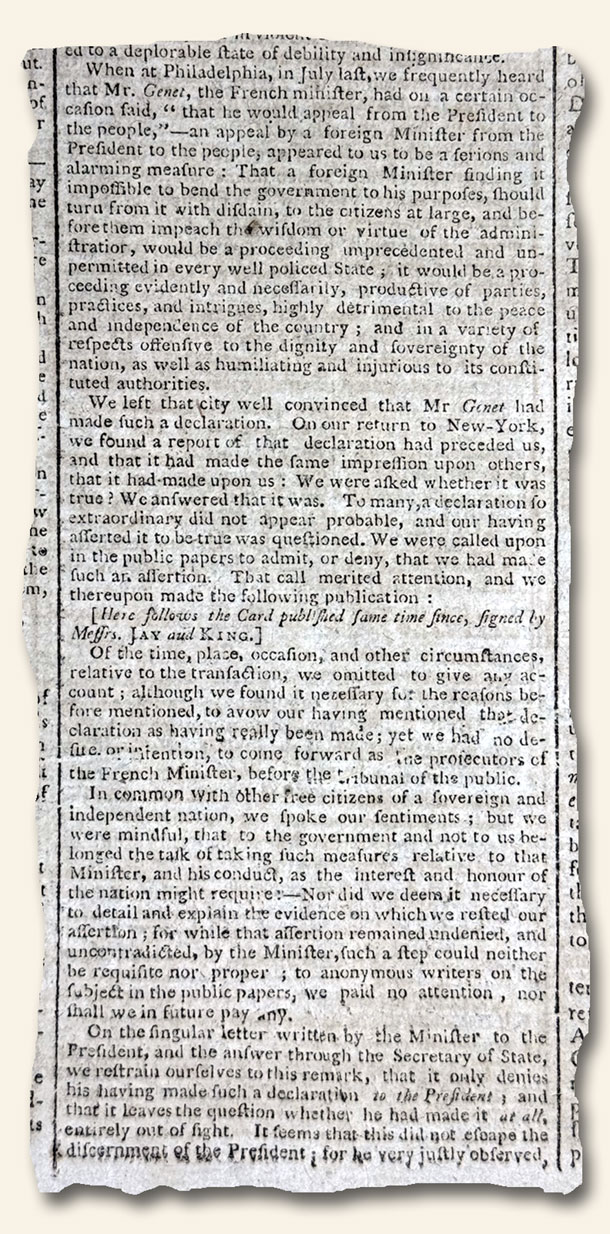
Lead-up to a Nation… as reported in the newspapers of the day (Intro & Sept., 1775)…
October 3, 2025 by GuyHeilenman · Leave a Comment
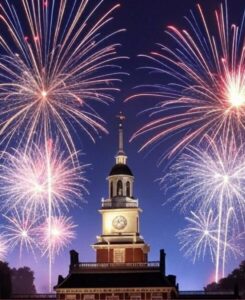
British News Delayed – Lead-up to a Nation (E5)
Lord Dunmore and Colonial Unrest – Lead-up to a Nation (E6)
Patrick Henry – Lead-up to a Nation (E7)
Benjamin Franklin – Lead-up to a Nation (E8)
We hope you are enjoying this year-long trek to the 250th anniversary of The United States through the eyes of those who were fully engaged, first hand. As mentioned previously, all accounts are rooted in what they read in the newspapers of the day.
“History is never more fascinating than when read from the day it was first reported.” (Timothy Hughes, 1975)
Announcing: Catalog #359 for October, 2025 – Rare & Early Newspapers…
September 30, 2025 by GuyHeilenman · Leave a Comment
|
|
The reason I collected it: our most remote newspaper yet…
September 15, 2025 by TimHughes · Leave a Comment
In addition to newspapers with historical content, or graphic presentations, or among the smallest (or largest) possible, another “extreme” that has fascinated me has been those that are exceedingly remote. We have an issue or two of the “Alaska Forum” which is the northernmost American newspaper to be found, but our discovery of “The Penguin Post” from 1957 trumps it in terms of being as close to one of the poles as possible.
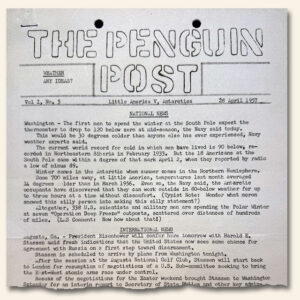 This is a fascinating “newspaper” from near the South Pole, published at “Little America V” in Antarctica. It has an intriguing history.
This is a fascinating “newspaper” from near the South Pole, published at “Little America V” in Antarctica. It has an intriguing history.
“Little America” was a series of Antarctic exploration bases from 1929 to 1958 located on the Ross Ice Shelf, south of the Bay of Whales. They were built on ice that is moving very slowly, the relative location on the ice sheet moves and eventually breaks off into an iceberg.
There were five such exploration bases, this being the last. Little America V was established on January 3, 1956, at Kainan Bay, some 30 miles east of Little America IV, as part of Operation Deep Freeze. Little America V served as the American base in the South Polar program in the International Geophysical Year, from July 1, 1957, to December 31, 1958. It was constructed by United States Navy Seabees in the three-month window before the Antarctic winter made construction nearly impossible. All of Little America V was constructed below the snow line in the ice, with individual living quarters, a generator room, a cafeteria, and ramps leading out at one end for tracked vehicles. This type of construction meant that none of those staying in Little America V had to go outdoors in the harsh winter when going from one section to another of the Antarctic town.
This–thus far–is assuredly the southernmost newspaper we have found.
Is it Patriot Day, Patriot’s Day, or are they interchangeable?
September 11, 2025 by GuyHeilenman · Leave a Comment
Is it Patriot Day? Yes. Is it Patriot’s Day? Yes again. Are they interchangeable? If someone had asked me yesterday, I would have thought they were one and the same; but the answer is: No! So, for those like me who thought they were one and the same, I hope what follows clears things up.
 Patriot Day
Patriot Day
Patriot Day is a United States observance held every year on September 11 to honor the nearly 3,000 people who lost their lives in the terrorist attacks on September 11, 2001. Established by a joint resolution of Congress and signed into law in 2002, the day commemorates the victims of the attacks on the World Trade Center, the Pentagon, and United Airlines Flight 93, as well as the first responders who risked and sacrificed their lives. Americans observe the day with moments of silence, memorial services, and the lowering of flags to half-staff as a tribute to national resilience and remembrance.
Shown to the left is a report from the Los Angeles Times, dated Sept. 11, 2001.
Patriot’s Day
Patriots’ Day is a U.S. holiday commemorating the battles of Lexington and Concord, the first military engagements of the American Revolutionary War, fought on April 19, 1775. It originated in Massachusetts in the late 19th century to honor the bravery and sacrifice of colonial militiamen who resisted British forces. The holiday is observed annually on the third Monday in April, primarily in Massachusetts and Maine, with re-enactments, parades, and athletic events like the Boston Marathon. Patriots’ Day serves as a reminder of the American colonies’ fight for independence and the birth of the United States.
The following is a report from The New England Chronicle dated Sept. 7, 1775.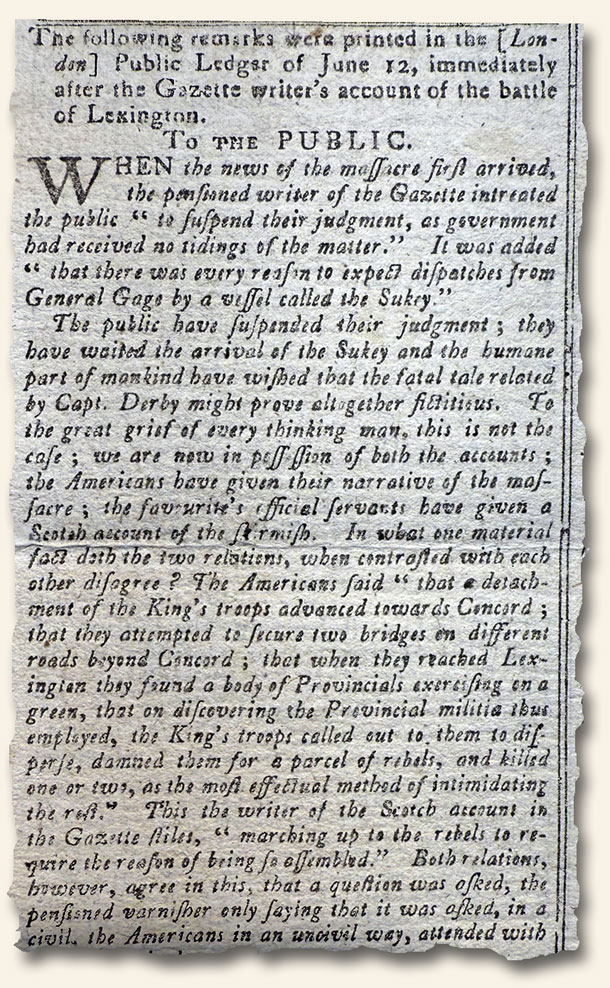
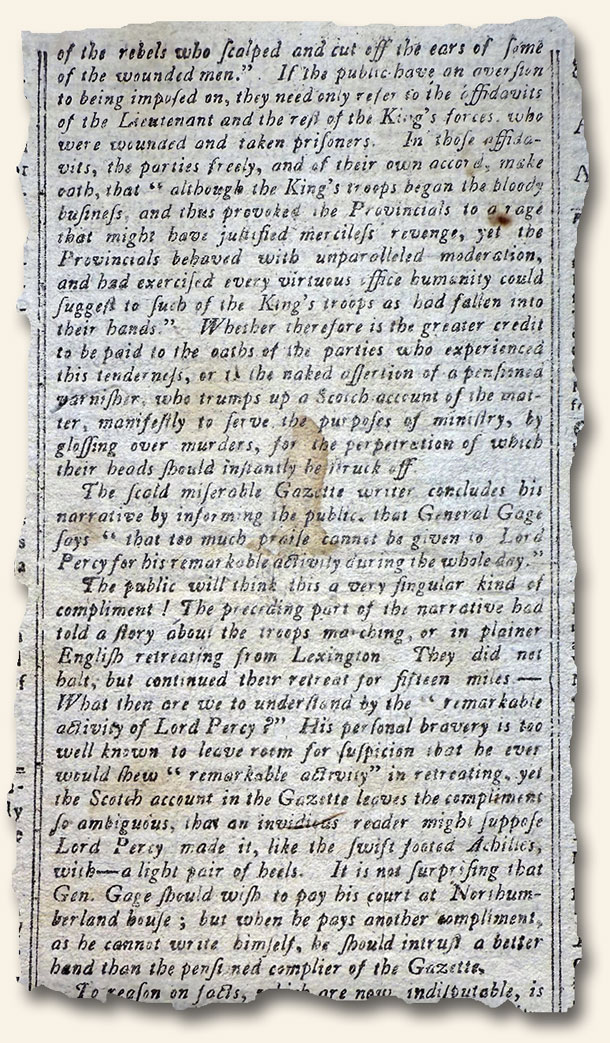
Singers & Songwriters – 1776 edition…
September 8, 2025 by GuyHeilenman · Leave a Comment
Flashback – 1776
“And, the award for the songwriter of the year goes to… ‘wait for it… wait for it…’* … Benjamin Franklin, for his chart-busting mega-hit: “The KINGS own REGULARS, and their TRIUMPH over the IRREGULARS.”
Was there anything this man could not do? I could be wrong, but if those who have explored the life of this amazing forefather were asked to list his talents and accomplishments, I’m guessing that “lyricist” would not make anyone’s list. Yet, although unsigned, the satirical ditty printed in the Pennsylvania Evening Post on March 30, 1776 (shown below) has finally been universally acknowledged as being from his pen (and not just an autopen with his name on it). Furthermore, the fact that it would have likely topped the charts in such an historic year (1776) makes him a shoe-in for eventual entry into the Musicians Hall of Fame and Museum. Sadly, whether through the distraction of competing interests, lack of funding, or perhaps the waning of ongoing inspiration, history has proven him to be classified as a “one-hit wonder”. What a shame; he was off to such a great start.


*Quote borrowed from Ketanji Brown Jackson, honorable Associate Justice of the SCOTUS.
Lead-up to a Nation… as reported in the newspapers of the day (Intro & August, 1775)…
September 5, 2025 by GuyHeilenman · Leave a Comment

Shown below are the first four installments.
The Necessity of Taking Up Arms – Lead-up to a Nation (E1)
The Olive Branch Petition – Lead-up to a Nation (E2)
The Speech of Edmund Burke – Lead-up to a Nation (E3)
England Declares War – Lead-up to a Nation (E4)
We hope you enjoy this year-long trek to the 250th anniversary of The United States through the eyes of those who were fully engaged, first hand. All accounts will be through what they read in the newspapers of the day. After all, as Tim Hughes proclaimed back in 1975: “History is never more fascinating than when read from the day it was first reported.”
A 49 year search comes to an end… The 1765 “Tombstone” issue…
September 1, 2025 by TimHughes · Leave a Comment
There are a number of iconic American newspapers that every collector desires, most are for content alone such as the Declaration of Independence, the Constitution, the assassination of Abraham Lincoln, etc.
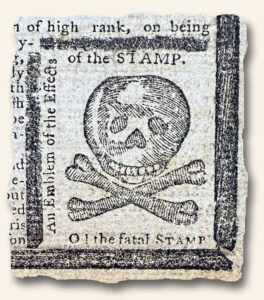 Not many are desired for both historical significance as well as graphic appeal, but such is the case with the Pennsylvania Journal of October 31, 1765. Having been aware of it for many years (photos are found in many high school history books), I had always been in the search for a genuine issue (beware: many reprints exist). I came close about 35 years ago when an institution, which had two in their collection, gave thought to exchanging one with me for an unknown Philadelphia newspaper I had discovered. Ultimately, they opted not to do the swap, so the search was back on.
Not many are desired for both historical significance as well as graphic appeal, but such is the case with the Pennsylvania Journal of October 31, 1765. Having been aware of it for many years (photos are found in many high school history books), I had always been in the search for a genuine issue (beware: many reprints exist). I came close about 35 years ago when an institution, which had two in their collection, gave thought to exchanging one with me for an unknown Philadelphia newspaper I had discovered. Ultimately, they opted not to do the swap, so the search was back on.
It ended earlier this year.
This particular edition, famously known as the “tombstone edition,” used striking visual and textual elements to express colonial outrage over the Stamp Act tax, which required many printed materials, including newspapers, to bear a revenue stamp. This tax directly impacted printers and publishers, placing a heavy economic burden on them and fueling widespread resistance.
As seen in the photos, the masthead featured a skull and crossbones, a powerful symbol representing the “death” of the press under the weight of the Stamp Act. Also, an engraving of a coffin appears at the bottom of the back page, captioned: “The last Remains of the PENNSYLVANIA JOURNAL Which departed this Life, the 31st of October, 1765, Of a Stamp in her Vitals, Aged 23 Years.”
Publisher William Bradford begins the issue with poignant commentary, including: “I am sorry to be obliged to acquaint my readers, that as The Stamp Act is fear’d to be obligatory upon us after the First of November ensuing (the fatal to-morrow) the publisher of this paper unable to bear the burthen, has thought it expedient to stop a while, in order to deliberate whether any methods can be found to elude the chains forged for us…”.
Published just one day before the Stamp Act’s enforcement, this edition cleverly voiced dissent without yet violating the law, making it a strategic act of defiance.
This “tombstone edition” of the Pennsylvania Journal captured this economic strain and transformed it into a public rallying cry.
This edition stands as a vivid example of how the colonial press used creativity to oppose British policies, contributing to the growing revolutionary sentiment. It underscores the critical role newspapers played in shaping public opinion and mobilizing opposition in the years leading up to the American Revolution.
While other newspapers also protested the Stamp Act, the Pennsylvania Journal’s dramatic tombstone imagery made it particularly memorable and influential. It galvanized public resistance, cementing its place as a powerful symbol of defiance in American history.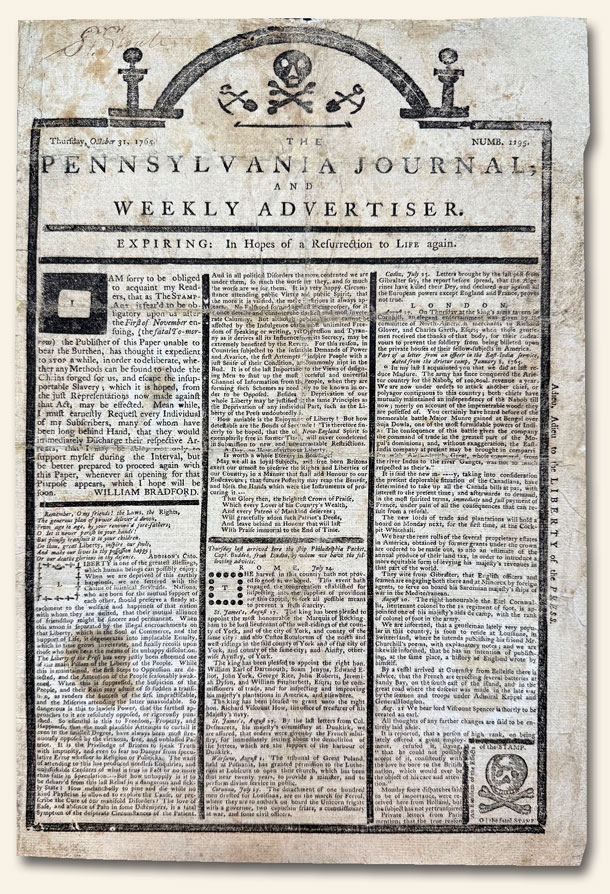





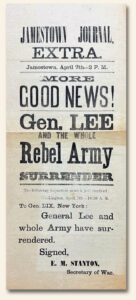 October’s catalog (#359)
October’s catalog (#359)